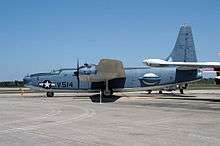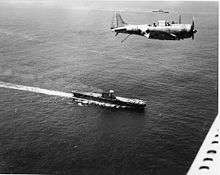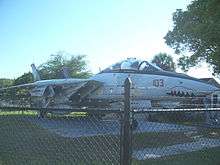Naval Air Station DeLand
| Naval Air Station DeLand | |
|---|---|
| IATA: none – ICAO: none | |
| Summary | |
| Airport type | Military: Naval Air Station |
| Operator | United States Navy |
| Location | DeLand, Florida |
| Built | 1942 |
| In use | 1942-1946 |
| Occupants | United States Navy |
| Elevation AMSL | 70 ft / 21 m |
| Coordinates | 29°03′59″N 81°17′02″W / 29.06639°N 81.28389°W |
Naval Air Station DeLand was a United States Naval Air Station located in DeLand, Florida from 1942-1946.[1] After the war, the airfield and associated infrastructure was redeveloped into DeLand Municipal Airport
History
DeLand Airport, pre-World War II
The City of DeLand first began developing a civilian airport in the 1920s, with the first asphalt runway laid on or about 1936. With the outbreak of World War II and the entry of the United States into the war in 1941, the City of DeLand donated the airport facility to the U.S. Navy in 1942 for development as a naval air station.
Official Opening
In 1942, the City of DeLand donated the facility that was located on the grounds to the U.S. Navy and it was renamed Naval Air Station DeLand on 17 November.[2] The airfield officially opened after several months of additional land acquisition and extensive military building construction. CAPT Tom Turner, the air station's first commanding officer, officiated. A Navy band had not yet been formed for the air station, so the DeLand High School band played for the opening of the base. Following still more extensive military construction, NAS DeLand's primary focus became advanced training for Navy flight crews in land-based Lockheed PBO-1 Hudson (later Lockheed PV-1 Ventura) and Consolidated PB4Y-2 Privateer patrol bombers, as well as carrier-based Douglas SBD Dauntless dive bombers.



The first planes to arrive at NAS DeLand were the Hudsons,[3] which had been transferred from Patrol Squadron 82 (VP-82) at NAS Quonset Point, Rhode Island. In addition to Quonset Point, VP-82 had previously employed these aircraft in training operations at NAS Norfolk, Virginia and detachment operations at NAS Argentia, Newfoundland and NAS Trinidad, BWI. This included the sinking by VP-82 of the German submarine U-656, the first U-boat sinking attributed to U.S. forces in World War II.[3] These aircraft subsequently served as the training nucleus for PV-1 Ventura operational training units at both NAS DeLand and nearby NAS Sanford until greater numbers of newer PV-1s became available.
PB4Y-2 Privateers training operations followed in 1943, with the first examples reaching operational Fleet squadrons in 1944. A "navalized" version of the U.S. Army Air Forces B-24 Liberator, the land-based bomber was reconfigured with a lengthened fuselage, greater defensive armament, modified engine cowlings and a distinctive, single vertical tail. With its 2,800-mile range, the Privateer was so useful that the Navy took delivery of 739 examples, continuing to use them well into the 1950s during the Cold War.[4]
Between PBO-1, PV-1 and PB4Y-2 training operations, several of the U.S. Navy's former and present day maritime patrol and reconnaissance (VP) squadrons operating the P-3 Orion and P-8 Poseidon trace their squadron lineage to being initially established at NAS DeLand with these earlier aircraft during World War II.[5]
When the SBD Dauntless dive bombers began to arrive, along with pilots and crew members, Ventura training was scaled back. Although the SBDs were aircraft that were being replaced by newer dive bombers in the Pacific Fleet, such as the SB2C Helldiver, it was the SBDs that were credited with sinking four of the Imperial Japanese Navy's aircraft carriers at the Battle of Midway.
In 1944, training operations in the F6F Hellcat carrier-based fighter also commenced at NAS DeLand, as well as an Advanced Carrier Navigation school for replacement pilots.[6]
Because support functions often exceeded the capability of the air stations uniformed officers, sailors and Marines, many of DeLand's citizens were also employed at the base in administrative and support roles and were paid wages that were a significant improvement over those the community had seen during the recently concluded Great Depression.[7]
Military Training and Exercises

Nine Mile Point on Lake George was also under NAS DeLand's control and was used as a practice bombing site with a Navy PBY Catalina seaplane stationed nearby in the event of an aircraft mishap on the lake. The Lake George site is still used today as part of the Navy's Pinecastle Electronic Warfare and Bombing Range[8] complex in the Ocala National Forest that is managed by NAS Jacksonville.[2] NAS DeLand also maintained a duty watch of two sailors to patrol Lake Woodruff in the event of any nearby naval aircraft mishaps.
NAS DeLand also had responsibility for an Outlying Field (OLF) located in New Smyrna Beach and bombing targets near Paisley, Hawkinsville, the Indian River Lagoon, and east of Lake Dias near DeLeon Springs. These facilities were also used by aircraft based at NAS Daytona Beach and NAS Sanford.
OLF New Smyrna Beach refueled and rearmed planes practicing landings at OLF Spruce Creek and conducting target practice over the Atlantic Ocean. These aircraft occasionally carried 500 pound bombs when they were over the ocean in the event any German U-boats were spotted.
Decommissioning
Following the end of World War II, the base closed as an active naval installation on March 15, 1946. Its control tower also closed and ownership of the air station returned to the City of DeLand as an uncontrolled civilian airport.[7] After the city resumed control of the field, it became DeLand Municipal Airport, a role it continues to this day.
Stetson University College of Law
From 1946 to 1953, the base was also home to Stetson University College of Law.[9] The law school was relocated to Gulfport (St. Petersburg), Florida, in 1954.[10]
DeLand Naval Air Station Museum

Located in the historic Chief Master at Arms House in DeLand, Florida, the DeLand Naval Air Station Museum was dedicated in 1995 and focuses on the history of Naval Air Station DeLand, U.S. Naval Aviation, and United States Navy history. Exhibits include an F-14 Tomcat on loan from the National Naval Aviation Museum, PTF-3 (a former USN Nasty class torpedo boat undergoing restoration),[11] a Grumman TBF Avenger torpedo bomber (undergoing restoration), a Korean War era H-13 Sioux MASH helicopter, a 1954 U.S. Army jeep, military artifacts, vintage photographs, and other memorabilia.
References
- ↑ http://www.delandnavalairstation.org/
- 1 2 "Florida in WWII - Historic Sites and Resources". Flheritage.com. Retrieved 2008-12-08.
- 1 2 http://www.microworks.net/pacific/aviation/PBO_Hudson.htm
- ↑ http://www.warbirdalley.com/pb4y2.htm
- ↑ "VPNAVY - VP-ML-1 History Summary Page - VP Patrol Squadron". vpnavy.com.
- ↑ http://www.museumoffloridahistory.com/exhibits/permanent/wwii/sites.cfm?PR_ID=76
- 1 2 http://www.delandhouse.com/books.htm
- ↑ http://www.militarybases.us/navy/pine-castle-bombing-range/
- ↑ Swygert and Vause, Florida's First Law School: A History of Stetson University College of Law, p. 203
- ↑ Swygert and Vause, p. 241
- ↑ http://www.ptf3restoration.org/historyofptf3.html
External links
![]() Media related to Chief Master at Arms House at Wikimedia Commons
Media related to Chief Master at Arms House at Wikimedia Commons